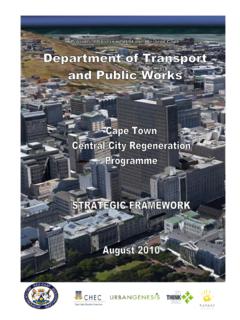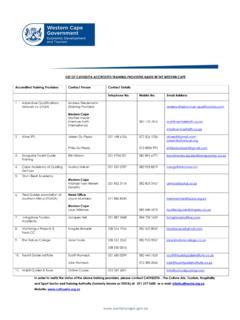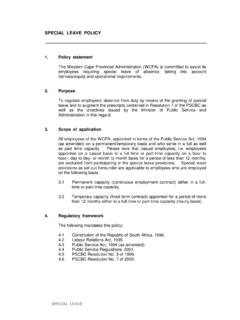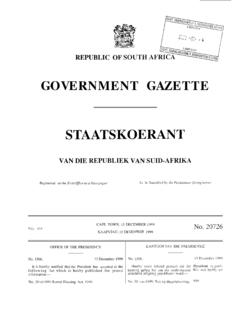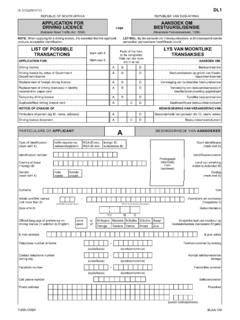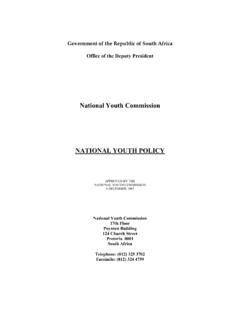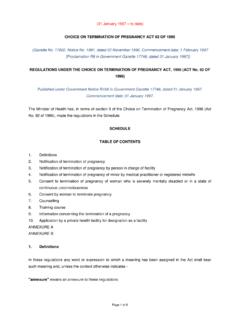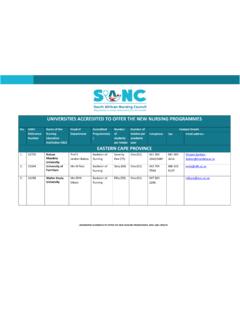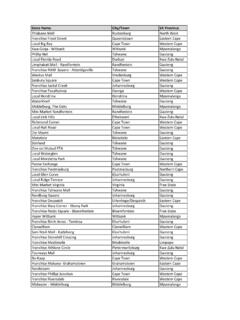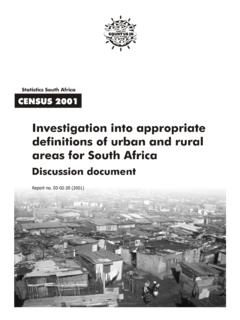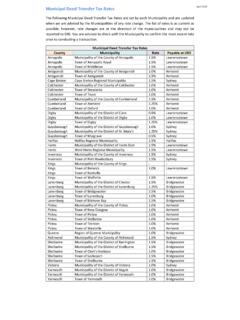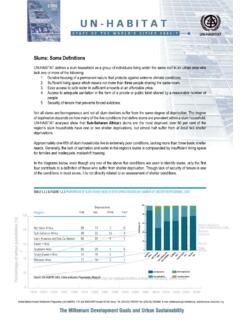Transcription of 7. WATER QUALITY - Western Cape
1 Western cape IWRM Action Plan: Status Quo Report Final Draft Status Quo Report DEADP 186 7. WATER QUALITY INTRODUCTION What is WATER QUALITY ? WATER QUALITY is a term used to express the suitability of WATER to sustain various uses, such as agricultural, domestic, recreational, and industrial, or aquatic ecosystem processes. A particular use or process will have certain requirements for the physical, chemical, or biological characteristics of WATER ; for example limits on the concentrations of toxic substances for drinking WATER use, or restrictions on temperature and pH ranges for WATER supporting invertebrate communities.
2 Consequently, WATER QUALITY can be defined by a range of variables which limit WATER use by comparing the physical and chemical characteristics of a WATER sample with WATER QUALITY guidelines or standards. Although many uses have some common requirements for certain variables, each use will have its own demands and influences on WATER QUALITY . WATER QUALITY is neither a static condition of a system, nor can it be defined by the measurement of only one parameter.
3 Rather, it is variable in both time and space and requires routine monitoring to detect spatial patterns and changes over time. The composition of surface and groundwater is dependent on natural factors (geological, topographical, meteorological, hydrological, and biological) in the drainage basin and varies with seasonal differences in runoff volumes, weather conditions, and WATER levels. Large natural variations in WATER QUALITY may, therefore, be observed even where only a single WATER resource is involved.
4 Human intervention also has significant effects on WATER QUALITY . Some of these effects are the result of hydrological changes, such as the building of dams, draining of wetlands, and diversion of flow. More obvious effects of human intervention are the polluting activities, such as the discharge of untreated or partially treated domestic; industrial, urban, and other wastewaters into the WATER resource (whether intentional or accidental); and the spreading of chemicals on agricultural land in the drainage basin.
5 A single influence ( feacal pollution, eutrophication or diffuse pollution) may give rise to a number of WATER QUALITY problems, just as a problem may have a number of contributing influences (DWA, 2010). What is this chapter all about This chapter provides an overview of WATER QUALITY and aquatic ecosystem monitoring in the Western cape as well a gap analysis to identify monitoring that needs to be undertaken in the province to fill some of the knowledge gaps that exist.
6 The present WATER QUALITY status is then reviewed for the Olifants/Doring WMA, the Berg WMA, the Breede WMA, the Gouritz WMA, and the small portion of the Western cape that extends into Fish to Tsitsikamma WMA. Sources of point and nonpoint source pollution are then reviewed and the chapter is concluded with a first assessment of priority pollution concerns that should be addressed. WATER QUALITY MONITORING Introduction Sound WATER QUALITY monitoring is essential for facilitating proactive management of WATER resources.
7 WATER QUALITY monitoring is undertaken for various purposes, namely (a) overall national WATER QUALITY status and trends, (b) compliance with resource QUALITY objectives, (c) compliance with WATER use licence conditions, including monitoring of affected WATER resources, (d) tracing deviations from background or baseline conditions, and (e) remediation efforts. This evaluation of WATER QUALITY monitoring programmes focuses on programmes that are aimed at detecting/describing WATER QUALITY status and trends at a provincial scale.
8 Western cape IWRM Action Plan: Status Quo Report Final Draft Status Quo Report DEADP 187 Definition of monitoring Monitoring refers to all physical WATER related monitoring systems that collect data and information to manage the resource in an integrated manner in accordance to the requirements of the National WATER Act (Act 36 of 1998) (NWA) and WATER Services Act (Act 108 of 1997). In accordance with chapter 14 of the NWA: 137. (1) The Minister must establish national monitoring systems on WATER resources as soon as reasonably practicable.
9 (2) The systems must provide for the collection of appropriate data and information necessary to assess, among other matters - (a) the quantity of WATER in the various WATER resources; (b) the QUALITY of WATER resources; (c) the use of WATER resources; (d) the rehabilitation of WATER resources; (e) compliance with resource QUALITY objectives; (f) the health of aquatic ecosystems; and (g) atmospheric conditions which may influence WATER resources. WATER QUALITY monitoring programmes A total of eleven resource QUALITY monitoring programmes are currently run by the Department of WATER Affairs (DWA), see Table The main purpose of these monitoring programmes is to assess the status of the WATER resources and track WATER QUALITY trends.
10 There are four main databases that are populated with monitoring data, these are: HYDSTRA: This is a commercial, off-the-shelf Hydrological Information System for the storage, editing, retrieval, manipulation, and analysis of surface WATER , WATER QUALITY , and groundwater time series data and related hydrological information in support of WATER resources management. NGIS: The National Groundwater Information System is a groundwater based portfolio of applications and projects which provides data storage, web-enabled capturing (capturing released in Oct 2008), and data dissemination capabilities for groundwater related data, tools for data and information representation as well as reporting.

